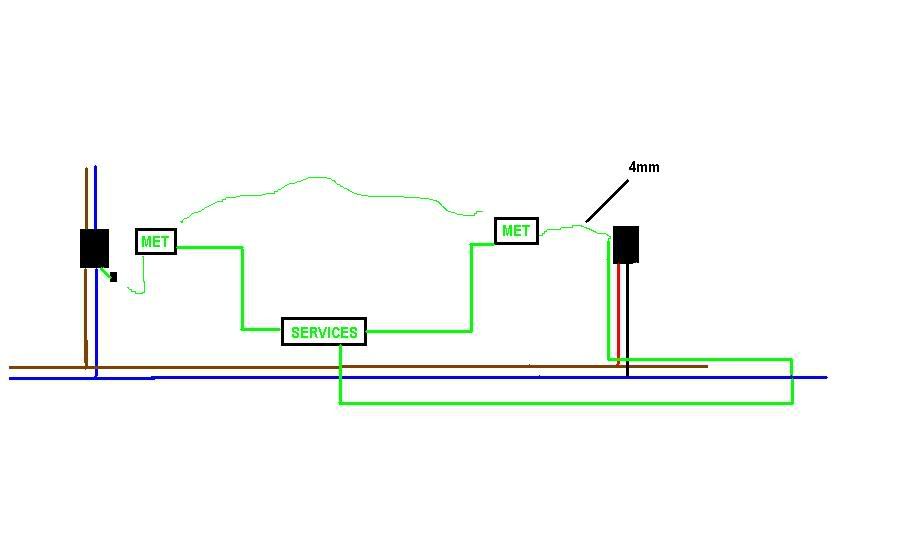hi. This may look quite long but im sure theres an easy solution to this.
There are 2 flats, one above the other in a detached property. The main supply came into a cutout in the downstairs flat, and from here, it was split into 2 sets of cables, one set for each flat. Earthing was provided by cable sheath (TNS), and this was also run upstairs. This earth cable is very minimal, approx 4mm. Both flats have main equipotential bonding in place.
The decision was made to install a brand new supply (PME) for the upstairs flat, and to disconnect the upstairs flat from the submains.
Siemens metering services arrived yesterday and initially refused to energise and install the new meter for the upstairs flat. They said that it could be unsafe for the upstairs flat to be on PME, and the downstairs on cable sheath. Any electrical fault upstairs could raise the metalwork in the downstairs flat (via water/gas pipes). They wanted the downstairs cutout changed to PME (remaining on its own supply cables), and then they would be happy. (I do not see how this would avoid voltages rising under fault conditions. Also as downstairs has main bonding, any user downstairs would remain in their equipotential zone)
Siemens came back the same day and did install the meter under pressure from London Energy, supplier for the upstairs flat (it would have otherwise been off-supply). He acknowledged that any risk would be very minimal, but if someone could reach metalwork in both flats, there could be a possibility of slight shock.
So: downstairs is on cable sheath earth, upstairs is (for now) also on cable sheath using the earthing cable that was already present. It has not been connected (yet) to the PME earthing terminal. This has been unofficially OK'd by Siemens, and officially OK'd by london energy.
My question: where do we go from here?? I would like to connect the upstairs onto PME terminal as it has lower external earth impedance, and i feel the cable sheath earth at 4mm is not sufficient for both flats. To keep the whole property in one equipotential zone, I would like the upstairs MET connected to the downstairs MET with 16mm cable. (note that due to main equipotential bonding in both flats, they would be connected anyway, but this would reduce any volt differences). The downstairs flat would remain on cable sheath too.
Does anyone feel they have any valid arguments, or quote specific regs against doing this?? Many thanks for your help on this matter.
There are 2 flats, one above the other in a detached property. The main supply came into a cutout in the downstairs flat, and from here, it was split into 2 sets of cables, one set for each flat. Earthing was provided by cable sheath (TNS), and this was also run upstairs. This earth cable is very minimal, approx 4mm. Both flats have main equipotential bonding in place.
The decision was made to install a brand new supply (PME) for the upstairs flat, and to disconnect the upstairs flat from the submains.
Siemens metering services arrived yesterday and initially refused to energise and install the new meter for the upstairs flat. They said that it could be unsafe for the upstairs flat to be on PME, and the downstairs on cable sheath. Any electrical fault upstairs could raise the metalwork in the downstairs flat (via water/gas pipes). They wanted the downstairs cutout changed to PME (remaining on its own supply cables), and then they would be happy. (I do not see how this would avoid voltages rising under fault conditions. Also as downstairs has main bonding, any user downstairs would remain in their equipotential zone)
Siemens came back the same day and did install the meter under pressure from London Energy, supplier for the upstairs flat (it would have otherwise been off-supply). He acknowledged that any risk would be very minimal, but if someone could reach metalwork in both flats, there could be a possibility of slight shock.
So: downstairs is on cable sheath earth, upstairs is (for now) also on cable sheath using the earthing cable that was already present. It has not been connected (yet) to the PME earthing terminal. This has been unofficially OK'd by Siemens, and officially OK'd by london energy.
My question: where do we go from here?? I would like to connect the upstairs onto PME terminal as it has lower external earth impedance, and i feel the cable sheath earth at 4mm is not sufficient for both flats. To keep the whole property in one equipotential zone, I would like the upstairs MET connected to the downstairs MET with 16mm cable. (note that due to main equipotential bonding in both flats, they would be connected anyway, but this would reduce any volt differences). The downstairs flat would remain on cable sheath too.
Does anyone feel they have any valid arguments, or quote specific regs against doing this?? Many thanks for your help on this matter.


